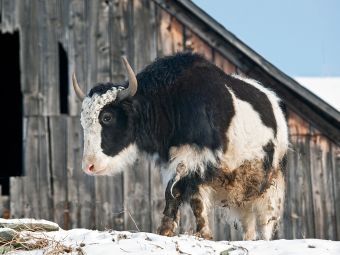
Visit The VPR Table Homepage
Can Vermonters yak it? Bringing the Himilayan bovine to Vermont could be a smart mooooove.
Tune in to The VPR Table Friday evening at 5:55 and Saturday morning at 8:55 to learn more about the Yak in Vermont.
According to James Beard Award-Winning Food Author Rowan Jacobsen, "You can raise three times as much
yak on an acre of grass as you can cow. Yaks climb hills with ease and don’t
care for grains; they are grass-fed purists. Their meat has a nice beefy
flavor."
——————-
One of my favorite
drives in Vermont is the stretch of Route 100 heading south from Middlesex
through Moretown, Waitsfield, and Warren. The snow-capped mountains. The sudden
glimpses of the Mad River curling through its valley. And the yaks, of course.
Yes, yaks. South of Moretown, just
before you reach Waitsfield, an old dairy farm appears to your right, and
roaming the hilly paddocks above the farm are about forty black, horned, very
shaggy bovines. This is the herd of the Vermont Yak Company, New England’s only
yak farm.
The Yak company was started two
years ago by three couples in the Mad River Valley who wanted to revitalize an
old dairy farm back to life that still boasted acres of lovely green pasture.
They could have raised cows on the farm, but they went with yaks instead.
Why? Well, that’s where it gets
interesting.
One of the couples involved, Kate
and Rob Williams, had met some yaks in Montana. And they had noticed the same
thing that everybody first notices about yaks: Yaks are really tough. Native to
the Himalayas, their idea of a good time is muscling through blizzards on
15,000-foot mountain passes, pawing through the snowdrifts for a few mouthfuls
of dried grass.
This makes them a good fit for
Vermont. When it’s twenty below, they couldn’t be happier. You don’t need a
barn. Yaks hate barns. They want to be out all the time-Unlike cows, which
favor the cushy life.
Yaks, accustomed to roughing it in
Tibet, have evolved into much more efficient grazers than cows. You can raise
three times as much yak on an acre of grass as you can cow. Yaks climb hills
with ease and don’t care for grains; they are grass-fed purists. Their meat has
a nice beefy flavor.
Which leads me to wonder whether
the yak’s time has come in Vermont. Why did we get so wedded to cows, after
all? Because they were available. They were convenient. But admit it: That cow
on the state flag has always looked a little weird-almost as weird as the
sheaves of wheat. Picture, if you will, a whole new state flag, with snowy
hills peppered with great, shaggy beasts sporting cool horns. It could happen,
and it could take us, as Rob Williams would say, YAK to the future.
—————–
Learn more about the Vermont Yak Company.
Stuck In Vermont: Vermont Yak Company Episode.